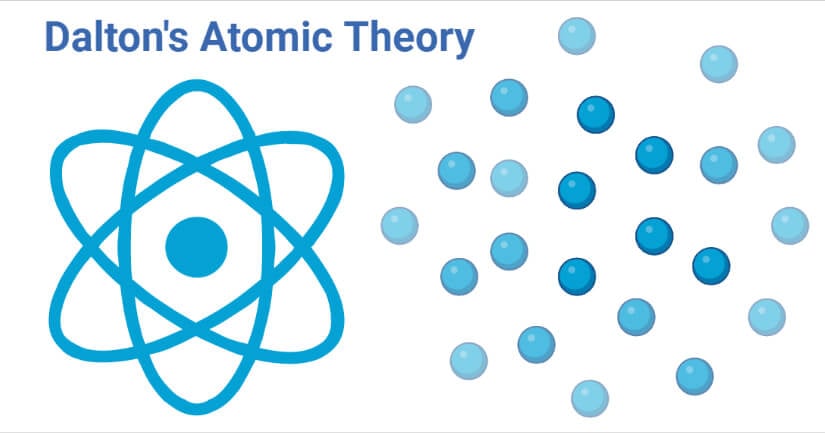Who is John Dalton?
- John Dalton (6 September 1766- 27 July 1844) is an English meteorologist, teacher, and chemist who postulated the atomic theory and is considered a pioneer in modern chemistry.
- John Dalton has made numerous contributions to different areas of science, but one of his most important contributions is the introduction of the atomic theory in chemistry.
- Besides the atomic theory, John Dalton also introduced other concepts in chemistry like gas laws. His work on color blindness was also quite popular as Daltonism became a common term for color blindness.
- Dalton introduced atomic theory via a series of articles called ‘A New System of Chemical Philosophy’ which was published in 1803.

What is Dalton’s atomic theory?
- Dalton’s atomic theory is a scientific concept which states that all matters are composed of tiny indivisible and discrete particles called atoms.
- The atomic theory was developed by John Daltons after he made the observation that chemical substances combine and break down into other substances by weight which suggested that such chemical substances are made of smaller particles with a particular weight.
- Dalton’s atomic theory is based on two other important chemical laws of the time; the Law of conservation of mass by Antoine Lavoisier and the Law of definite proportions by Joseph Proust.
- Dalton, in the atomic theory, also introduced the word atom as the most fundamental particle of a chemical substance.
- In modern chemistry, Dalton’s atomic theory has been modified due to some of the drawbacks in the principle.
- The most essential concept of Dalton’s atomic theory is the suggestion that all matters are composed of atoms, but there are other different concepts in the form of postulates of the theory.
Postulates of Dalton’s atomic theory
The following are the main postulates of Dalton’s Atomic Theory;
- All matters are composed of tiny, indivisible, and discrete particles of units called atoms.
- Atoms are the most basic unit of a chemical species that do not undergo any division during a chemical reaction.
- Atoms follow the law of conservation of mass and can neither be created nor destroyed during chemical processes. These particles can also not transform into the atoms of other elements. This is called the principle of the indestructibility of matter.
- Atoms are specific to elements, and all the atoms of a specific element are similar in all aspects and also have the same mass. The atoms of different elements, however, are different and have different mass as well as other properties.
- During a chemical combination process, the combination of two elements occurs by the union of the elements in a simple whole-number ratio to produce a compound atom (molecule).
- The mass of elements combining during a chemical process indicates the total mass of atoms combined during the process.
- In a given compound, the number and kinds of atoms are constant.
- The properties of different elements are respective of the properties of the atoms present in the elements.
Read Also: Covalent Bond- Definition, properties, types, formation, examples
Merits of Dalton’s Atomic Theory
- Even though over the years, different drawbacks and limitations have been observed in Dalton’s atomic theory, the theory has played a crucial role in the development of the modern atomic theory.
- Dalton’s atomic theory is the first study to differentiate between elements and compounds based on their fundamental differences.
- The theory combines and follows the law of definite proportions, the law of conservation of mass, and the law of multiple proportions.
- Dalton’s atomic theory was among the first studies to answer many unanswered questions of the 19th century.
Drawbacks/Limitations of Dalton’s Atomic Theory
Dalton’s atomic theory has different drawbacks and limitations and doesn’t reflect the modern atomic theory ultimately. The following are some limitations and drawbacks of Dalton’s atomic theory;
- The theory states that atoms are fundamental particles that are indivisible, but it has been demonstrated that atoms are composed of subatomic particles like electrons, the nucleus, and protons.
- According to Dalton’s atomic theory, atoms are indestructible, but in modern chemistry, atoms have been destroyed and created through nuclear fission and fusion.
- Dalton stated that atoms of a specific element are identical in mass, but the concept has been proved wrong by the discovery of isotopes. Isotopes are atoms of the same element with different masses.
- One of the postulates of Dalton’s atomic theory states that atoms of different elements have different masses, but the atomic mass of two elements has been found to be the same. For example, argon and calcium are different elements with the same atomic mass (40 AMU).
- The formation of non-stoichiometric compounds and heavyweight molecules discards the postulate that atoms combine in simple whole-number ratios.
- Dalton’s atomic theory fails to account for the existence of allotropes of the same element. For example, the theory fails to differentiate between charcoal, graphite, and diamond.
References and Sources
- Gautum SD, Pant M and Adhikari NR (2016). Comprehensive Chemistry, Part 2. Sixth Edition. Heritage Publishers and Distributors, Pvt. Ltd.
- https://chemistrygod.com/dalton-atomic-theory
- 3% – https://byjus.com/chemistry/daltons-atomic-theory/
- 2% – https://www.toppr.com/guides/chemistry/some-basic-concepts-of-chemistry/daltons-atomic-theory/
- 1% – https://www.oxfordreference.com/view/10.1093/oi/authority.20110803095605292
- 1% – https://www.khanacademy.org/science/ap-chemistry/atoms-compounds-ions-ap/compounds-and-ions-ap/a/daltons-atomic-theory-version-2
- 1% – https://www.jove.com/science-education/11242/the-atomic-theory-of-matter
- 1% – https://www.encyclopedia.com/science/encyclopedias-almanacs-transcripts-and-maps/john-dalton-proposes-his-atomic-theory-and-lays-foundation-modern-chemistry
- 1% – https://quizlet.com/450940307/chemical-reactions-balancing-classifying-flash-cards/
- 1% – https://quizlet.com/360796098/chemistry-basics-flash-cards/
- 1% – https://quizlet.com/153840076/chapter-2-atoms-and-elements-flash-cards/
- 1% – https://en.wikipedia.org/wiki/Dalton_atomic_theory
- 1% – https://chemistrygod.com/dalton-atomic-theory/
- <1% – https://www.topperlearning.com/answer/what-are-the-major-drawbacks-of-daltons-atomic-theory/92tp7kii
- <1% – https://vibdoc.com/encyclopedia-of-chemistry-science-encyclopedia.html
- <1% – https://sites.google.com/site/daltonsatomictheorysite/home/changes-in-dalton-s-atomic-theory
- <1% – https://courses.lumenlearning.com/introchem/chapter/john-dalton-and-atomic-theory/

Thank you for notes